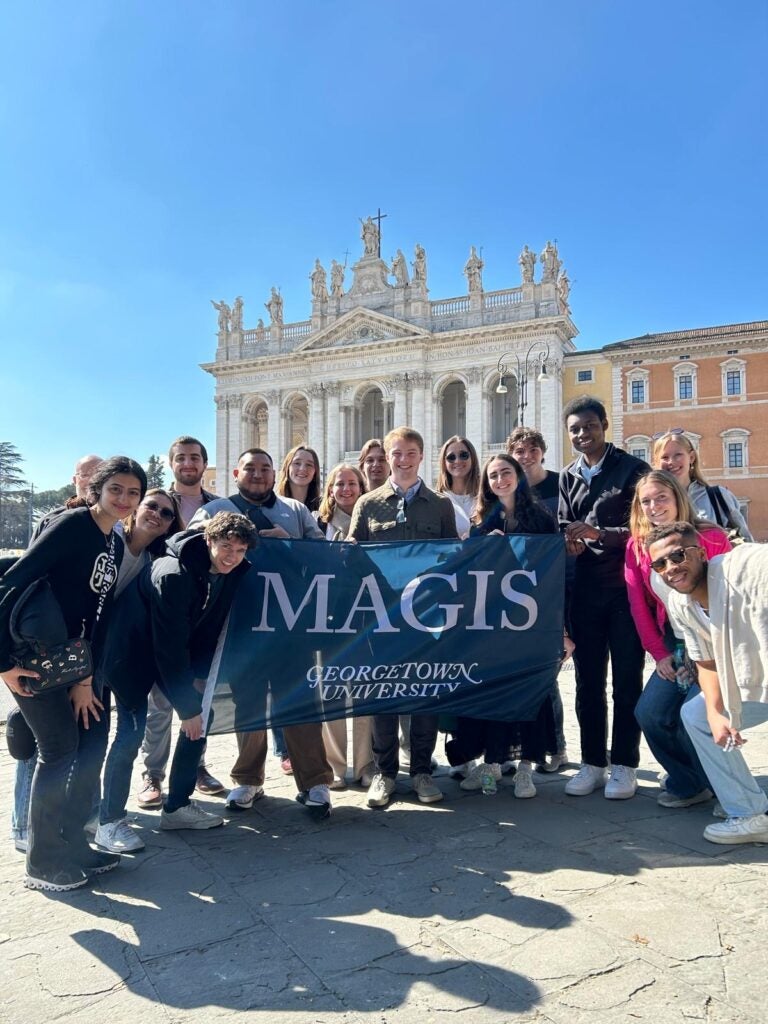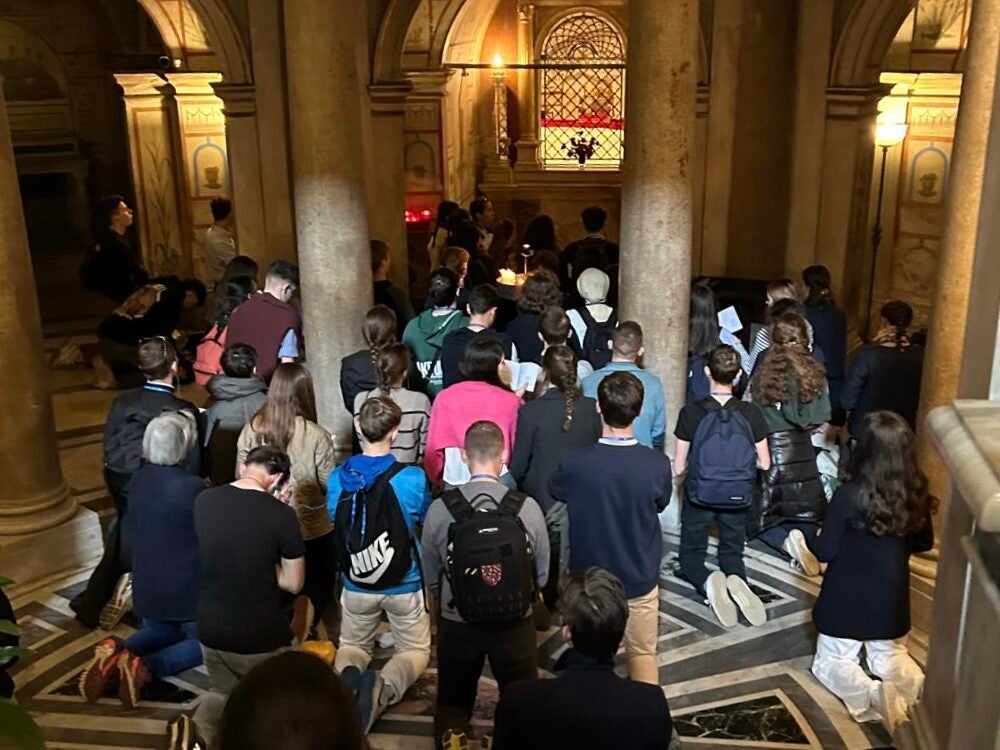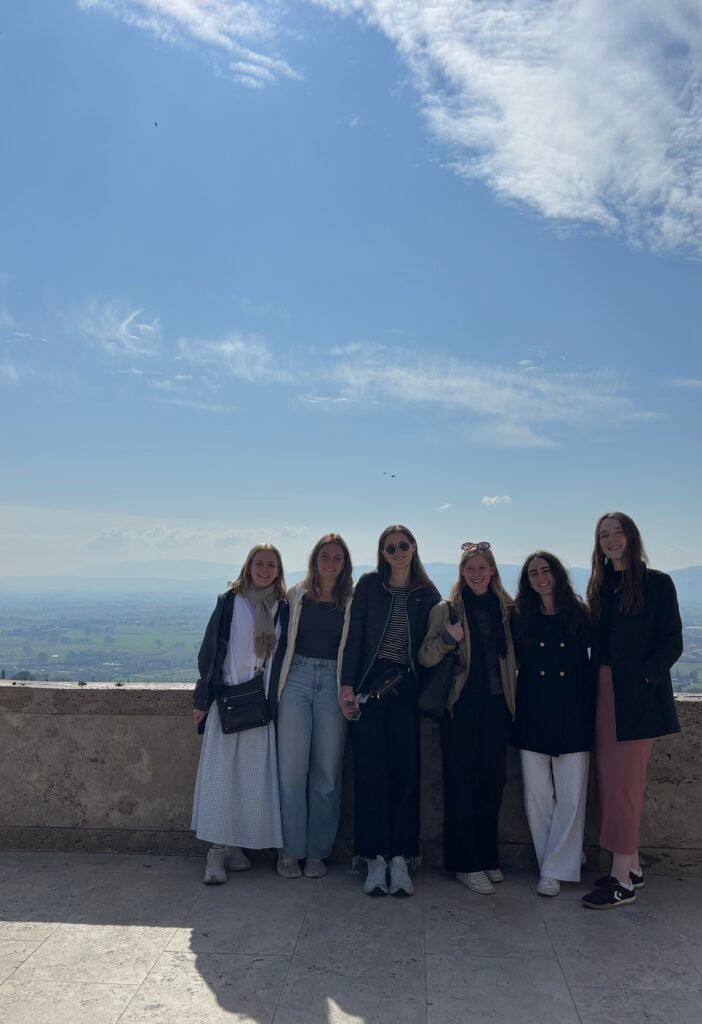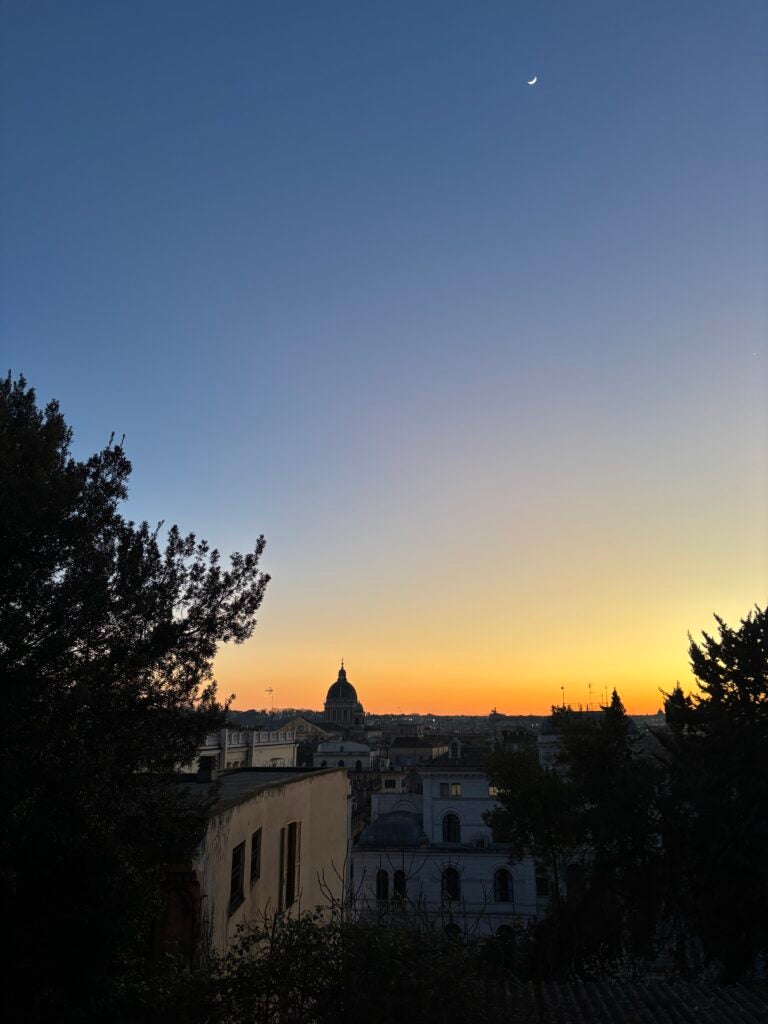Magis Immersion Seminar: A Roman Pilgrimage of Exploration, Reflection, and Faith
A Photo Essay by Isabela McNeilly-Anta (SFS’27)
One of the more unique ways that Georgetown University supports academic excellence, cura personalis, and holistic education is through the Magis Immersion Seminars. Each topic of the experiential learning opportunity includes rigorous in-class learning that explores the theological, historical, political, and other facets of a culture, then invites the students to immerse themselves in the culture with an on-the-ground weeklong trip during Spring Break. Some students are recipients of the Rome: The Matteo Sachman Theology of Pilgrimage Seminar endowed fund, in honor of the life of Georgetown student Matteo Sachman and his dedication to serving others. Below is the photo essay reflection by Isabela McNeilly-Anta (SFS’27) who visited Rome and Assisi, Italy, in March, 2025.
As part of the Magis Immersion Seminar: Theology of Pilgrimage, taught by Jesuits Frs. Mark Bosco and Andy Downing, I joined 15 other students on a pilgrimage of our own to Rome over spring break. In class, we became accidental scholars of pilgrimage—the Camino, the Hajj, the Appalachian Trail, and the Shikoku islands. We plunged into the medieval Church’s theology of sacred travel and unpacked Protestant and Catholic frameworks through two spiritual memoirs: the Puritan classic Pilgrim’s Progress and A Pilgrim’s Journey (because what would a good Jesuit theology class be without St. Ignatius?).
Less than an hour after our plane touched down Saturday morning, we’d dropped our bags at Casa Santa Lucia Filippini—our home for the week—and rushed out to start the day. We had no time to waste.

Our class with the MAGIS Immersion Seminar flag outside the Archbasilica of St. John Lateran—the highest-ranking of the four papal basilicas in Rome, serving as the official seat of the Pope.
Our exploration began with the Roman Forum, where centuries of history have been unearthed by archaeologists. Without bulldozers or demolition equipment, the Romans simply built each empire on top of the last, leaving modern Rome with a question: dig deeper, or preserve the most recent layer of civilization?

Ruins of the Roman Forum; Arch of Septimius Severus, built in 203 AD in celebration of Roman military victories in the East.
That echo of history was especially loud this year. Our visit happened to align with one of the Church’s most sacred and rare traditions. Celebrated once every 25 years, a Jubilee Year opens the Holy Doors of the city’s four papal basilicas to pilgrims seeking grace, renewal, and mercy. Pope Francis declared Jubilee 2025 “A Pilgrimage of Hope.”
Our class sought out these basilicas—St. Peter’s, St. Paul’s Outside the Walls, St. John Lateran, and Maria Maggiore. Walking through St. Peter’s square, praying the Litany of Saints, we passed Bernini’s iconic obelisk, a medieval sign to illiterate pilgrims, flagging churches as holy sites.

Vatican City; Carrying the cross into our first Holy Door at St. Peter’s Basilica. We woke up at 6 am for this.
Our first Holy Door was composed of sixteen bronze panels, each depicting a critical moment in salvation history. The Catholics among us ran our fingers over carved faces and lambs, tracing stories we’d heard since childhood. At each door, Fr. Bosco encouraged us to pray for all those who have “loved us into life”—brothers, teachers, friends, and coaches who supported and sculpted us into who we are. At Maria Maggiore, we prayed specifically for our mothers, who have loved us unconditionally, and without reserve, no matter how messy our rooms got.
As pilgrims, after passing through the four Holy Doors during a Jubilee Year, completing the sacrament of reconciliation, and receiving communion, we received a plenary indulgence—a removal of all temporal punishment due to sin.

French pilgrims and Georgetown students knelt side by side in a moment of shared prayer.
Another significant component of our trip was prayer, in all its forms. Once, we encountered a chorus of French high schoolers, singing hymns as they moved between churches. Words alone couldn’t capture the reverence and beauty of their voices—it kept us in the crypt long after we’d finished praying.
Our journey ended with a day trip to Assisi, home of St. Francis, the patron saint of animals, ecology, and the poor. Born into a wealthy family, Francis underwent a radical conversion after illness and time at war, ultimately renouncing his wealth to live a life of simplicity and service. In 2013, Jesuit Jorge Mario Bergoglio—better known as Pope Francis—declared that the Catholic Church must become “a Church of the poor, for the poor.”

David, by Gian Lorenzo Bernini, Galleria Borghese.
While in Rome, we fully immersed ourselves in the city’s rich artistic heritage. From Caravaggio to Bernini, our eyes feasted on the ceilings of even the smallest chapels. I was most struck by the Baroque style, which emerged in 17th-century Rome as a dramatic, accessible form of visual theology—crafted to captivate and move the poorer parishioners who stood at the back, unable to read Latin or access a Bible.

Standing with classmates at the Sacred Convent of Saint Francis in Assisi.
Also tucked away in Assisi, is the tomb of Blessed Carlo Acutis. As a child, the soon-to-be patron saint of the internet created an online exhibition on Eucharistic miracles. While saints are meant to be role models, the centuries that separate us often reduce them to anecdotes. But Carlo feels real. He had our modern distractions: sneakers, a computer, and headphones—and still chose a life of holiness. When I found out he was here, I practically ran to the chapel.

Sunset over Rome, taken during an evening walk near the Spanish Steps.
Pilgrimage is also about who you become afterward—how you’ve changed as a person. Returning to Georgetown, I’ve reflected on the gifts I carried home. Beyond gaining a deeper understanding and appreciation for Roman history, art, and (dare I say) food, this trip profoundly shaped my spiritual life. Rome holds a quiet but confident culture of Catholicism, with churches literally around every corner—each one inviting and unassuming. After encountering a living, breathing faith firsthand, I’ve decided I want to order my life more intentionally around God—to become the person I was created to be.
Isabela McNeilly-Anta (SFS’27) is studying International Political Economy, French and International Business Diplomacy at Georgetown University. All photo credits are theirs.
